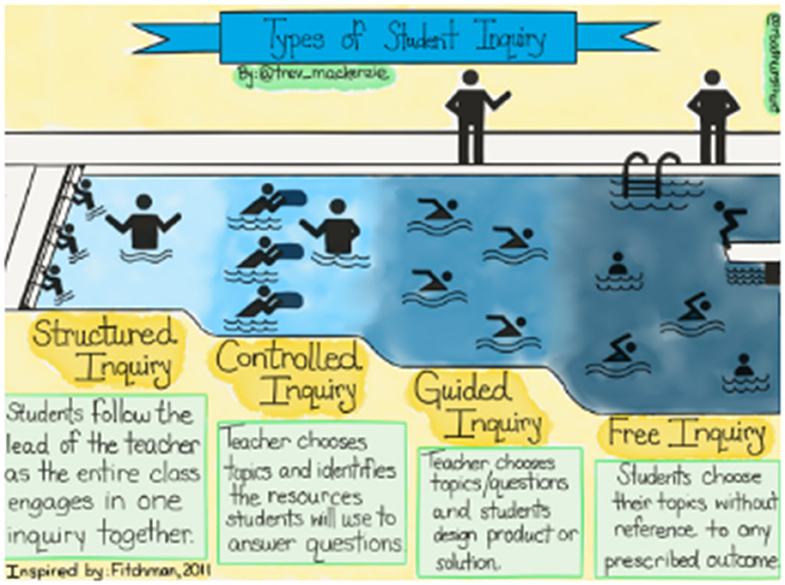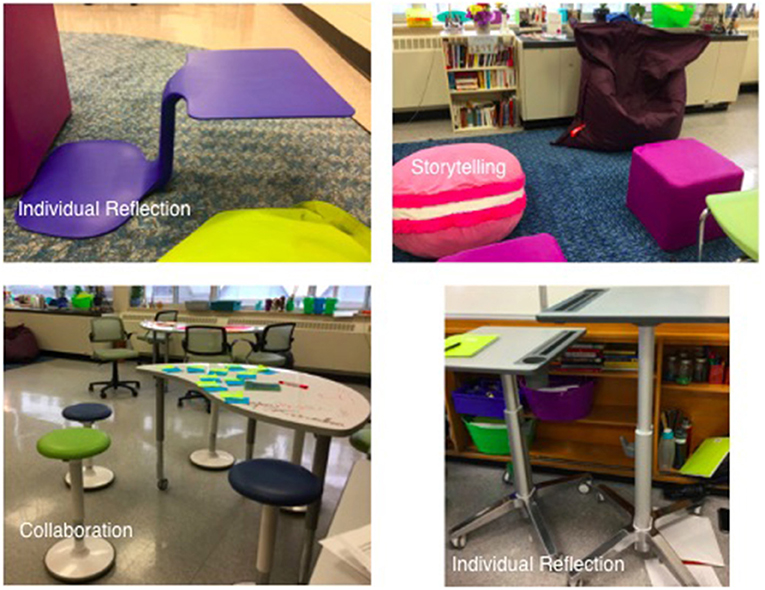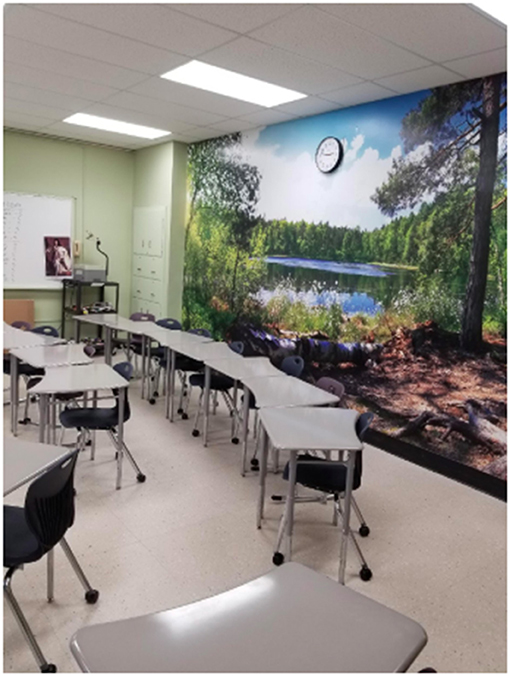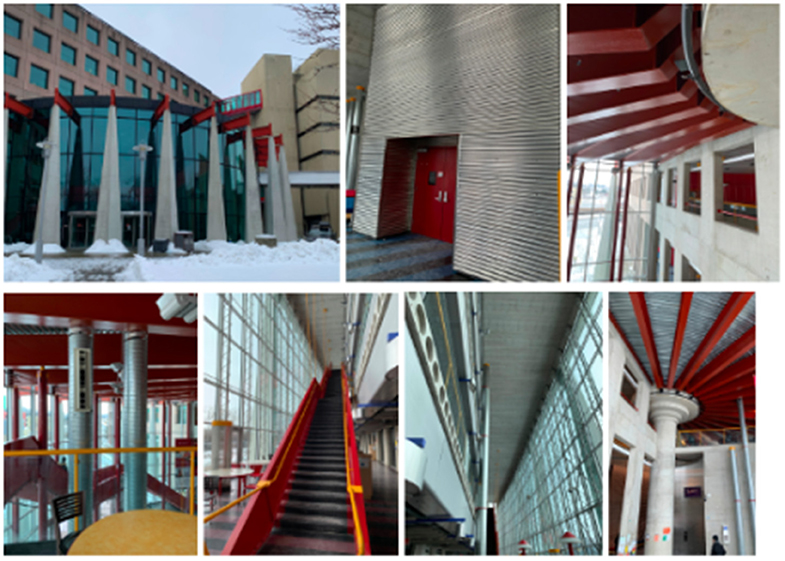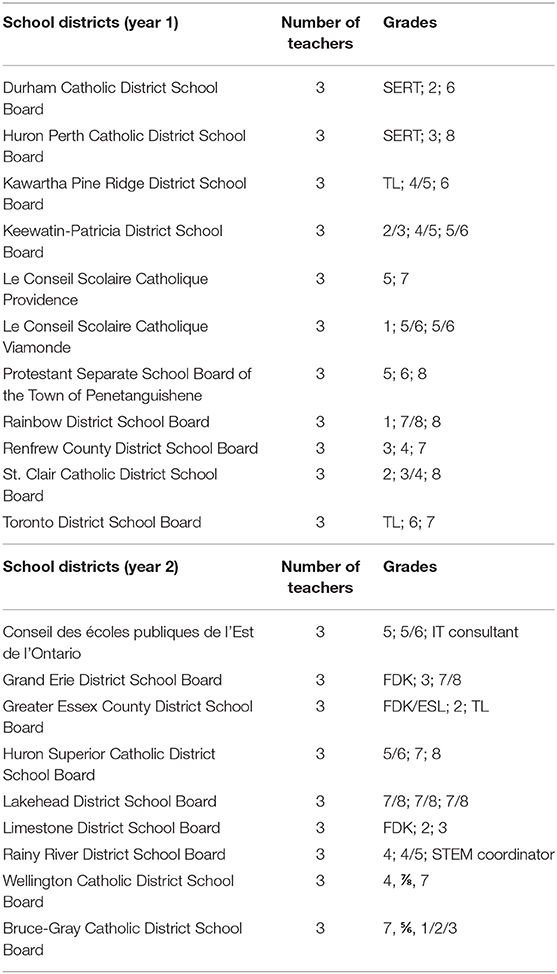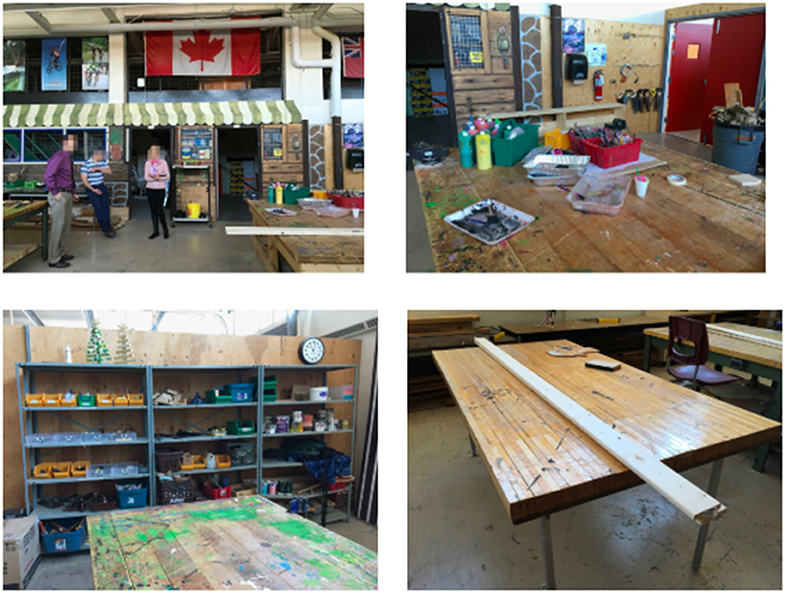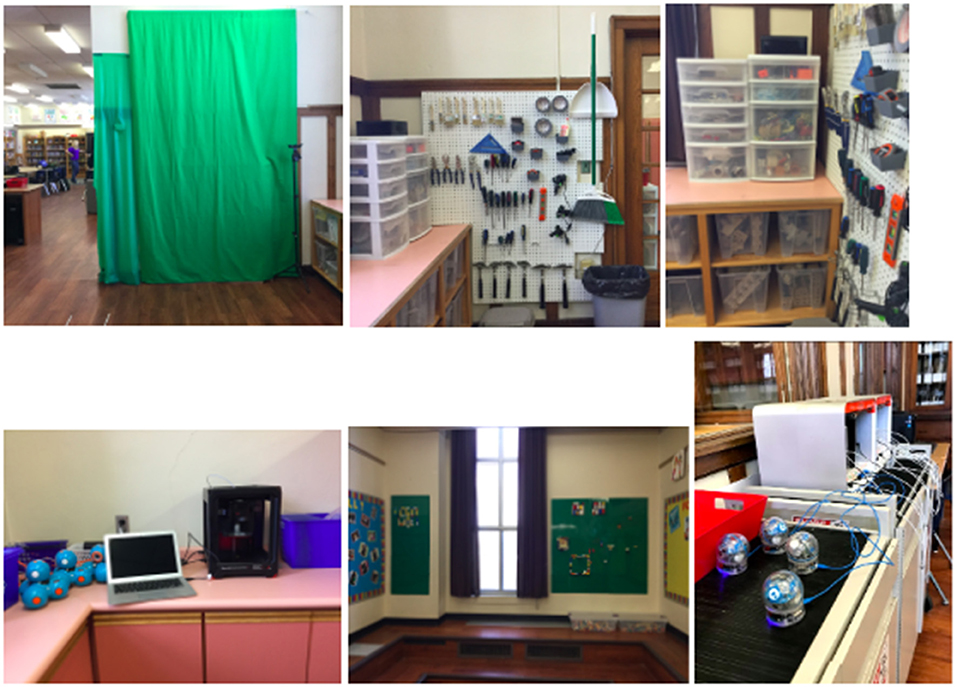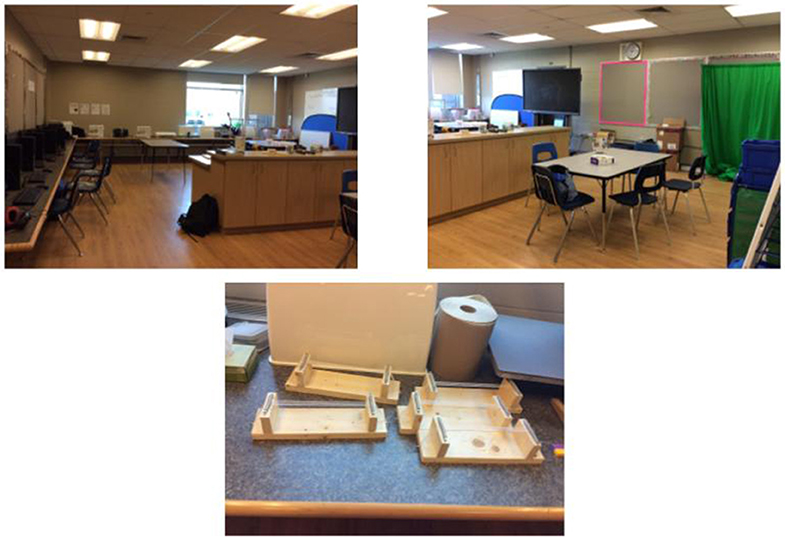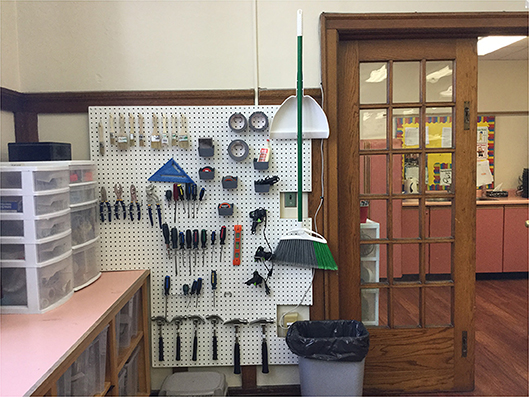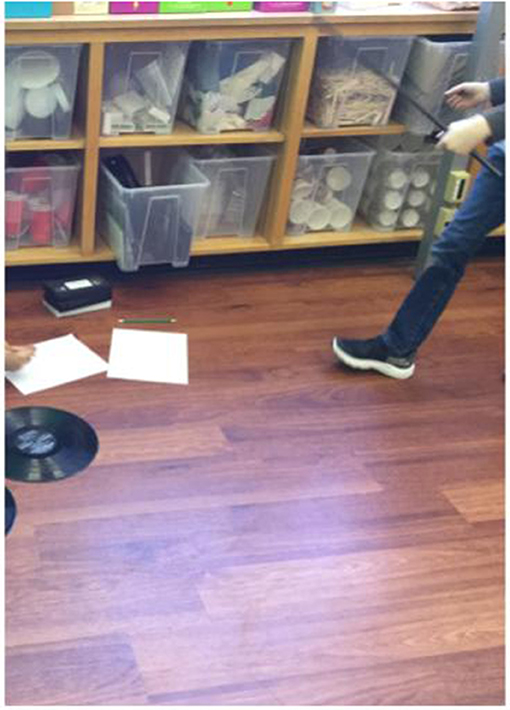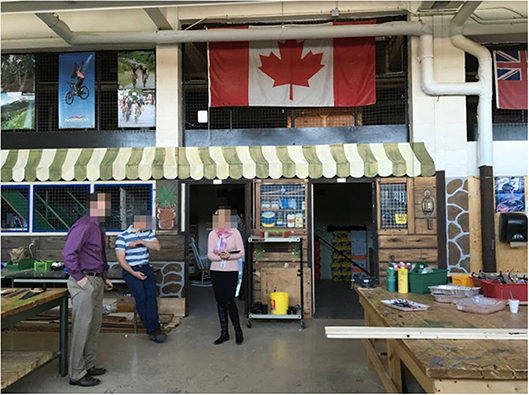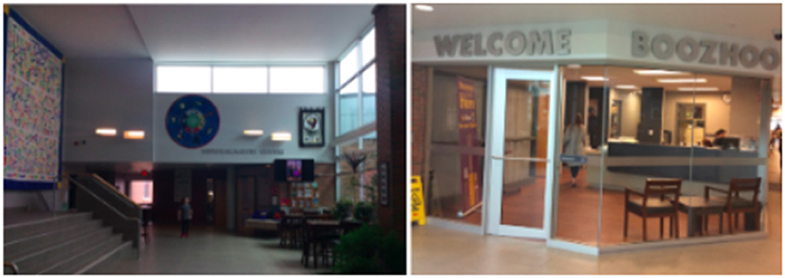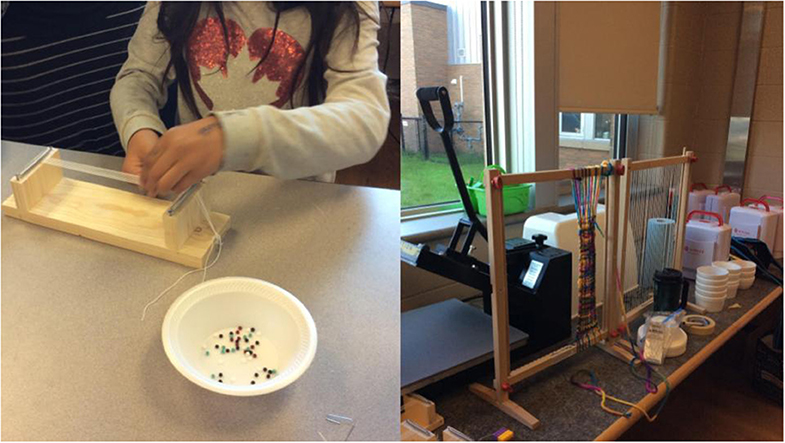- Faculty of Education, Ontario Tech University, Oshawa, ON, Canada
This article details a qualitative, case study focusing on the affordances of innovative makerspaces for teaching and learning. The theoretical perspectives framing the research include embodied learning, materiality, neuroarchitecture, and structuralism as it relates to power, inclusion, and engagement within a learning space. Findings provide an overview of how the physical space (including the architecture of, and the furniture and materials within, the space) became an actor in the learning process. Three schools are highlighted as the case study examples. A detailed overview is provided of each of the spaces and the findings are supported through rich descriptions and a variety of data sources (i.e., teacher quotes, Twitter posts, images). This study is timely given that many Ontario schools have been and continue to build makerspaces to respond to the need to develop students' global skills and competencies (critical thinking; innovation and creativity; self-directed learning; collaboration; communication; and citizenship).
“There is no doubt whatever about the influence of architecture and structure upon human character and action. We make our buildings and afterwards they make us. They regulate the course of our lives”
-Winston Churchill, 1924
Introduction
In a typical classroom setting, tension exists between working within the constraints of an outdated system and implementing ministry-led or innovative initiatives such as differentiated instruction, inquiry-based, and student-centered learning, to name a few. Unfortunately, educational institutions are notoriously slow when it comes to making change (Lehman and Chase, 2015), even in light of the technological advances in recent years (Tondeur et al., 2017). Reconfiguring one's classroom into a “makerspace,” however, is one potential solution to this tension. A makerspace is a space where people come together to make things, build, hack, remix, take-apart, and rebuild. Importantly, it is a community of people who learn through exploration, collaboration, problem-solving, and being creative and innovative. Converting classrooms to makerspaces reduces the tension of implementing innovative initiatives in an outdated system as the “grafting-on and hope it sticks” approach to change is supplanted with a totally new approach built from the ground up. A makerspace's physical space, the tools used in the space and type of learning that occurs within the space, require a totally new ethos that bears little, if any, resemblance to the old way of doing education. These new pedagogies are commonly referred to as production or maker pedagogies and they “…promote important principles including inquiry, play, imagination, innovation, critical thinking, problem solving, collaboration, and personalized learning” (Hughes, 2017). There are many different types of inquiry that occur in a makerspace and these are articulated clearly in the following graphic from MacKenzie (n.d.) (Figure 1).
The graphic depicts the gradual release of “power” or teacher involvement on the continuum of inquiry. In the shallow end, the teacher has the most control—this is where “structured inquiry” occurs. Here, all the students in a class follow the teacher in one, common inquiry. The next stage is referred to as “controlled inquiry.” In this approach, the teacher still maintains a sizable degree of control as they select both the topics and resources that guide the students in their inquiries and learning. In “guided inquiry,” the teacher steps to the sidelines (in the role of a facilitator) and selects the topics or questions, while the students design an artifact or create a solution in response to the prompts. Finally, in the deepest end of the pool is where the teacher monitors from the sidelines as students engage in “free inquiry” or open inquiry. At this stage, the students have control over what, where and/or how they learn. This shift in pedagogy needs to be supported through the physical learning space, which is another actor (along with the teacher, students, and curriculum) in the teaching and learning process. Nordquist and Watter (2017) point out, “If ‘space' is not changed when ‘curriculum' is changed, one could end up with a lack of alignment. It is assumed that space must be designed and developed so as to enable a smooth implementation of the curriculum” (p. 328). This could be extended to include the smooth implementation of the new pedagogies that support that new curriculum. The inquiry process (which is similar to the engineering design process and involves non-linear iterations of reflection, information gathering, creation, and sharing) mirrors what futurist Thornburg (2004) discusses as the three metaphorical sites of learning: the campfire where experts or teachers share knowledge through storytelling; the watering hole where information is shared with peers and knowledge is developed, and the cave where knowledge is individually internalized (reflected on, understood, synthesized). A classroom that physically supports these three important sites of learning is essential for the inquiry process. The example in Figure 2 demonstrates how these sites of learning might be realized in the classroom. Through movable furniture, the space below could be organized, when necessary, to facilitate a campfire, watering hole or cave for students. For example, there are areas for storytelling from an expert (top right), areas for collaboration at group tables (bottom left), and areas for individual reflection and knowledge internalization through individual floor and standing desks (top left and bottom right).
Connected to the idea that there is an important relationship between physical space and learning, Sullivan (2012) also argues that as “expanding curricula place new demands on students, the school facility is increasingly becoming a crucial part of the learning process” and that even things such as “improper school furniture can detract from student performance and health”. Determan et al. (2019) assert that “[l]earning spaces have the potential to impact generations through the employment of design strategies that promote early academic success and ignite a positive trajectory in a young person's life” (p. 2). As one way of addressing needed reform to school facilities and their impact on student health, they
…encourage education design decision makers at K-12 and higher education institutions to embrace biophilic design as another example of how the design of the space contributes to student well-being, academic success and helps put young people on a trajectory for a happier and more prosperous life (p. 24).
The emergence of the biophilic approach combined with greater attention to ergonomic design and collaboration can be seen in many new learning commons in Ontario. Many of these spaces now use curvilinear tables and seating options (consistent with biophilic design), movable furniture designed for moments of collaboration and independent learning, more comfortable seating options (i.e., bean bag chairs, standing work stations) and attention to colors like greens and blues and calming murals of nature (Figure 3).
While investigating the impact of makerspaces on the teaching and learning process in 20 school districts across Ontario over the course of 3 years, we noticed that the physical re-design of many school classrooms, learning commons, and old technical rooms facilitated an important shift in how, when and why students engaged in their learning. In Ontario, and around the world, there is an emphasis on global competencies (i.e., critical thinking; innovation and creativity; self-directed learning; collaboration; communication; and citizenship); therefore, there does not appear to be a better time to focus on getting physical learning spaces aligned with the curriculum. The purpose of this research was to explore innovative learning spaces in three different school contexts and determine their impact on the teaching and learning process.
Theoretical Perspectives
Embodied Learning and Materiality
If, as Glenberg's (2010) embodiment framework suggests, “…all psychological processes are influenced by body morphology, sensory systems, motor systems and emotions” (p. 586), then greater attention needs to be paid to this in the design of physical learning environments. As Barsalou (2010) articulates, the body and the environment are “external informational structures that complement internal representations” (p. 717). There is an important connection between the physical (building, making to represent a concept) and the internal, cognitive functions (Stull et al., 2018). As a result, a well-designed physical environment could positively influence hands-on activities and internal cognitive processes connected to learning, such as theoretical concept attainment. In regard to makerspaces specifically, Jaatinen and Lindfors (2019) have found that a makerspace's physical space should guide and support users in problem-solving. They explain that the space in their study
…which was designed to include a basic workplace, various material technology workstations and wider workshops (e.g., digital fabrication, wood work, sewing, engineering and weaving), was considered a holistic makerspace with well-defined areas of working and paths for moving from one workstation to basic workplaces or other workstations. This approach facilitated pupils' multifaceted opportunities to design and fabricate solutions to important problems… (n.p.).
The space and the user's physical interaction within the space impacted positively on cognition and the process of solutions finding.
Closely related to embodiment theory, is materiality. In the context of making, materiality is taken to mean the influence the material objects in the makerspace have on the creative process and design decisions of the maker. There is an important interaction that occurs between a designer, the design materials and set-up or layout of a space (Keune and Peppler, 2018). There is often a dialogue, conversation and/or an exchange where the designer is influenced by the materials/space and these, to a degree, facilitate or constrain the subsequent choices the designer may or may not make in their design. Tan et al. (2017) remind us, “As we design our everyday learning environments, we need to consciously engage these material histories as we select materials (digital and physical) to be used in the design process as well as when we design physical learning spaces” (p. 192). Tondeur et al. (2017) discuss how the physical layout of the classroom (including positioning of plugs, floor space, etc.) are “…defining factors [that] impact the ways in which technologies can be positioned in the classroom” (p. 282). These will, in effect, impact how one exists in, moves through, and interacts with the space. Tan et al. (2017) explain that, “[b]esides exposing participants to different types of materials to help them touch, feel, imagine, and connect to their ideas and imagination, the physical environment should also support the discovery of new properties of materials, new techniques, and the incubation of new ideas” (p. 193). So, the physical making and learning environment should be constructed with an eye to the facilitation of innovative ideas—introducing or creating a space of the possible.
Crawford Barniskis (2016) found that there are key elements that need to be considered when designing a makerspace (in this case in a library) connected to materiality. Crawford Barniskis (2016) argues that exposure is “the most critical aspect of the arrangements in these creative spaces” (p. 8). She explains that the affordances of a space (including what and how to access tools and what kind of making they can facilitate) need to be made obvious in order to invite user engagement (facilitating the shift from observer of the space to user within the space). She also found that users like to see finished projects in order to know what is possible within the space and to become inspired.
The Built Environment and Psychology: Neuroarchitecture
Although research in the field is still emerging, studies have shown there is a connection between architectural design and human psychology. This emerging area of research is often referred to as neuroarchitecture, which is a discipline that looks at the relationship between the built environment and human responses—cognitive, socio-emotional, and other physiological responses. A study by Mehta and Zhu (2009) explored cognitive task performance and its relation to color. Those participants in rooms colored red tended to perform better on detail-oriented tasks while those in rooms colored blue tended to perform better on tasks related to creativity. This is similar to the study conducted by Meyers-Levy and Zhu (2007) that found that ceiling height may prime the thinking of those within a room to either think more abstractly, as in a room with a high ceiling, or more confined, as in a room with a low ceiling. While their study was specifically interested in how “ceiling height may affect the very manner in which consumers process information and thus how they respond to products” (p. 175), the study and its findings have implications for education, as well, given that students' thinking and learning may also be influenced by their environments.
Other studies (Li and Sullivan, 2016; Yin et al., 2018; Determan et al., 2019) have found that space that incorporates the natural world has the ability to, among other things, reduce stress and increase attention, and memory. University of Waterloo neuroscientist Ellard (2015) explains that one's environment impacts emotions, thoughts, and physical responses. Ellard (2015) found there is an important connection between buildings and their exterior facades and the emotions produced in passers-by. Pedestrians reported negative emotional responses to blank building facades as determined via self-reporting and physiological instruments measuring skin conductance. While this may, at first, seem disconnected to education environments, it raises the question of what impact interior and exterior school design might have on teachers and students.
Mott et al. (2014) have found improved student outcomes, specifically in reading performance, related to increased light levels. Similarly, the study on workplace related stress by Thayer et al. (2010) found that cortisol levels were higher for employees working in office environments with poor lighting and air quality. Other research (Wu et al., 2014; Li and Sullivan, 2016) has found an important connection, too, between students' access to natural views and improved attention and achievement. It is posited that natural views provide necessary metal breaks for improved cognitive functioning and focus. Humans have a tendency to seek out and to find comfort and rejuvenation in the natural world as it has the ability to reduce stress and associated physiological responses (Li and Sullivan, 2016; Determan et al., 2019). Determan et al. (2019) explain that “[r]eal and simulated views of nature are not the only way to create a biophilic experience. Nature can also be represented in patterns, finishes and objects that have biomorphic forms and fractals…Experiences of fractals in the built environment that have the characteristics of those most found in nature lead to measurable stress reduction responses – heart rate, blood pressure and galvanic skin responses” (p. 5). One reason for this is that nature patterns may be easily processed by the brain's visual system (Albright, 2015). These studies, taken together, raise additional questions about current educational infrastructure and whether or not the physical environment is encouraging emotions and responses associated with being psychologically present, inspired and open or if these buildings and their tendency toward utilitarian design are communicating something else. While this question cannot be adequately answered within the scope of this paper, it is important to keep in mind as the question intersects with the findings in this paper as they relate to spatial redesign and the positive implications for student engagement and learning.
Power, Inclusion, and Space
Space is never neutral. As Lefebvre (1974) discussed in The Production of Space, space is a social construction—it is a product of history, of invisible socio-political factors and it is controlled by the hegemonic class to assert and maintain dominance and control. This is closely tied to ideas by Gramsci (1988) and Foucault (1978). In essence, both hold that the dominant class maintains dominance via a complex ideological structure. In keeping with this theoretical positioning, one might look critically at the current STEM, engineering and maker-related buildings, and spaces and question for whom and by whom these were built (Figure 4).
Many of these spaces, which tend to prioritize an industrial aesthetic (with exposed ducts and pipes, for example) and a neutral (grays, metals, black) color palette, appear to have been built to reflect the history of the hegemony embedded in STEM. These buildings tend not to consider or borrow elements from the natural world, nor do they reflect alternative ways of being and knowing outside the western (male) perspective. If spaces are socially constructed, additional voices and influences need to be part of the conversation to make these places more accessible, inclusive and reflective of those who have historically been excluded. This is necessary in order to encourage use of the spaces by those traditionally marginalized. The 2017 Horizon Report provides a brief overview of the ways some formal learning environments around the world are being modified through design for greater inclusivity as “[t]hought leaders in the field agree that these new learning spaces must move from an industrial model to one that is more student centered” (Freeman, 2017, p. 18). The authors of the report go on to outline how the spaces are being redesigned to facilitate greater collaboration, differentiated instruction/learning and technology integration and that “[a]cross the globe, schools are attempting to become sustainable and accessible communities” (p. 18). The authors provide a specific example of the International School of Kazan, Russia, “both the exterior and interior spaces are welcoming, using bright colors that reflect the Tatar traditions of the region. The design is versatile, allowing for redesign at any time in the future as learning models and student needs evolve” (p. 19). This formal learning environment has been designed to reflect and meet the needs of the community.
While the Horizon Report (2017) provides some good examples of innovative school initiatives and redesigns, traditional buildings and learning spaces are still the norm—spaces that reinforce the inequities found in the status quo. This type of architectural bias can even be seen in spaces that are considered public, such as libraries. Crawford Barniskis (2016) explains that “[l]ibrary creative places shape the possible actions and experiences of those using them through policy and practice, including the planning and implementation of spatial arrangements” (p. 1) and that “[s]uch socially constructed space is power-laden. Power relations are often invisibly embedded in the affordances intentionally or unintentionally designed into the spaces” (p. 1). An example of this power imbalance can be seen in who (user vs. library staff) has access to what, when and how. Griffis (2013) explains that elements within a space, like doors, communicate distinctive messages. Doors are “about making access heavily conditional” (Griffis, 2013, p. 121). Of his reserach, Griffis (2013) shares
For example, although users at all three case libraries are allowed to access such rooms as local history rooms, board rooms, and meeting rooms, these often remain locked during normal operating hours. This makes a system of filtering necessary, and thus library staff are required before unlocking any doors to determine who wants access to a particular room and why (p. 121).
In unpacking this phenomenon, Crawford Barniskis (2016) states that “[e]ach organization plans and executes its spatial arrangements according to some coordination of values, needs, mission, and physical limitations…The arrangements of tools and materials within the space demonstrates how the library interprets its use, and how it legitimizes particular activities or groups within the space” (p. 2). Black and Pepper (2012) similarly explain that, historically speaking, public library design has been a “successful exercise in ‘social engineering'—which can be defined as a collection of techniques designed to control, change, or manipulate people's attitudes, actions, or social behavior” (p. 446). Crawford Barniskis (2016) suggests that “librarians may wish to reevaluate the power relations between the institutional actors and users to recalibrate their message from ‘keep out' to ‘come in”' (p. 9). The sections below provide an overview of our study and the findings that emerged as they relate to this shifting message of inclusion, use and engagement.
Methodology
We drew on elements of emergent and interpretive design to investigate the phenomenon of innovative learning spaces within the context of a qualitative, case study approach. A qualitative approach was appropriate as our goal was to capture the movements, experiences and interactions of the participants in their spaces. A case study approach was also appropriate as we considered each school a case, bounded by time and space (Stake, 2005). In this way, we were able to draw cross-case comparisons between what we were observing in the physical spaces and whether or not our observations and interpretations held true across multiple sites.
Research Design
The research spanned 2 years and involved 20 different school districts in Ontario. The schools were selected based on a representative cross-section of the types of public schools found in Ontario: there was a mix of French, English, Catholic, and Protestant along with a mix of rural/urban, low-, medium-, and high-SES, multi- and predominantly mono-ethnic populations, and FNMI populations (First Nations, Metis, Inuit). Twenty elementary schools and 60 teachers were involved. Below is Table 1 that provides an overview of the districts, teachers and the grades taught in the larger study.
The study included 2 days of professional development for the participants at our university at the beginning of each year, where they learned about maker culture, pedagogies, and tools through hands-on learning. The teachers then returned to their schools to set-up unique makerspaces and to source and purchase the maker tools they felt would be best suited to their maker context and their school community needs. During the school year, our research team kept in touch with participants and followed their progress via Twitter and a common hashtag, created specifically for the project. Members of the research team visited each school approximately two to three times in each year of the project (travel to the more remote northern schools was restricted to one or two visits due to challenging winter conditions and/or the availability of the research team to travel to these more remote sites). Where possible, the visits were spread out throughout the year beginning in the fall and continuing with a follow-up visit in the winter and a final visit to the schools' maker faires in the spring (May or June). The purpose of these visits was to observe, consult and provide additional, context-based professional learning to the teachers involved in the study. At the end of the second year, the teachers were grouped by region (North, South, East, and West) and invited back to our university (or a more centrally convenient location, depending on the region) for targeted professional development focusing on making and subject-integration. This also served as an opportunity for the educators to engage in some innovative cross-board collaboration, planning and ideas-sharing. At the end of the study, guided, open-ended interviews were conducted regarding the teachers' observations, experiences, and feedback. It was here our team asked them to reflect on what challenges they faced, what worked well, why they made specific decisions related to the set-up of their makerspaces and what they might do differently in the future.
Data sources for this part of the study included photos of the schools' makerspaces, comments from teachers and principals related to their initial set-up, maintenance and development of the space, photos we took of the spaces on our site visits and photos the schools posted online via Twitter.
Participants and Setting
Within the scope of this paper, we focus on three of the cases within the larger study: Norbrooke, Princess Elizabeth, and Rocky Ridge (all pseudonyms) in order to provide an in-depth description and analysis of our findings. These schools were chosen using purposive sampling due to their unique spaces and the resultant making we observed within these spaces. At Norbrooke, the scale of many of the maker projects was “big” reflecting the cavernous physical space of the converted woodworking shop, at Princess Elizabeth the maker projects were informed by the organization and visibility of the tools and materials within the converted library and at Rocky Ridge the making was informed by the unplugged and culturally relevant tools and materials made available in the converted computer lab, which had a lot of floor space and ready-to-use collaborative stations. Each of the spaces were repurposed from their original beginnings which made the researchers take note of what the spaces afforded (i.e., space or storage) and what interesting making emerged from the spaces as a result. Below are vignettes detailing the participating schools.
Norbrooke
Norbrooke is a K-8 public school located in a rural community situated very near to a northern Ontario city. Norbrooke serves ~500 students from a number of surrounding small towns and provides programs in both English and French. The educators that took part in the study include Jeremy (all names are pseudonyms) (the tech lead and a grade 8 teacher), Janelle (the grade 1 teacher/French immersion teacher) and Bob (the grade 7/8 teacher, special needs teacher). The school itself was formerly a high school and was repurposed as an elementary school, so there was a very large tech space on the first floor that housed a wood and metal shop. The school chose to convert their old woodworking space into their makerspace. The space had lots of natural light, very high ceilings, high-table workstations, metal shelving with building and art materials on display and a variety of woodworking and other construction tools (Figure 5). There was ample space to move around, collaborate, and build. At the entrance of the woodworking space was a large alcove, about the size of a classroom, which the tech lead explained might be used for video and/or green screen production. In the back of the woodworking space was a lockable area ideal for equipment storage.
There were only two identified limitations of the space. The first was that it was located in an isolated area of the school and therefore not highly visible, so teachers would need to make a point of visiting or using the space. This was noted both by the teachers and the researchers and it was discussed in the first site visit as a potential challenge that may need to be addressed through active invitation to the space. The other limitation was that the teachers identified “…safety [was] sometimes a concern, dealing with saws…some power sanders, small corded sanders…” as the space had an emphasis on woodworking projects. So, extra care and attention needed to be provided to students using these tools.
Princess Elizabeth
Located in southern Ontario, Princess Elizabeth is an English language school that serves a diverse community with ~550 students. The student body is made up of those born in Canada and newcomers, including those from war-torn countries. Central to the school are English Language Learning programs and inclusionary/community-based practices. The educators that took part in the study include Kira (the teacher-librarian), Susan (the grade 2 teacher), and Cameron (the kindergarten teacher and prep coverage). The school chose to convert their library into a hybrid library/makerspace, so the space was large and had many different making stations. These stations included the green screen/video production area, the LEGO wall, the construction/building materials area and the robots, 3-D printer, laptops, tablets and other digital tools area, located close to outlets and the lockable storage room (Figure 6). The space was also infused with literature, found mostly on the other side of the space (this side of the space looked more like a traditional library with book stacks, a carpeted reading area and hexagonal tables).
There were few identified limitations to the space, but there were many affordances as identified by both the researchers and teachers. These were discussed in the first site visit to Princess Elizabeth. One major affordance was that the space had a mix of public-access storage in the library's main space and it also had a back office with lockable storage for the more expensive items, like laptops, and robots. This was important so the librarian could track the laptop/robot usage and return and any required updates/maintenance. Another major affordance of the space was that it was housed in a very central area of the school (what was previously the library) and as a result, the space was seen and used frequently by teachers and students. Even if teachers only brought their students to the library to take out books, they still had the opportunity to see what maker tools were available and/or to see maker lessons and activities in action. This encouraged use of the makerspace by teachers not originally involved in the study. The maker pedagogies, tools, and activities became common practice throughout the school community.
Rocky Ridge
Rocky Ridge is located in northern Ontario and serves a high population of Indigenous students. The educators who took part in the study include: Ben, the STEM coordinator, Jessica, the grades 4/5 teacher and June, the grade 4 teacher. The teachers in the study decided to repurpose their computer lab to accommodate making related activities. A bank of computers still line one wall. Sewing machines and a fabric press sit on a counter along the back wall, a projector screen and cupboards to store equipment are mounted on a third wall, and a green screen and lego wall take up much of the fourth wall (Figure 7). Three groupings of desks for small group work are at the back of the makerspace, with another larger group of desks at the front for a larger collaboration area. In the center of the room there is a higher work surface that students can stand at or use stools to sit at. Under this workspace is an area for storing wood and other larger materials. Although the space is no larger than a classroom, it is well-laid out and the setup enables a variety of different options for collaboration, while providing space for individual work, as well. Because the teachers and students do a lot of woodworking, which requires the use of hammers, drills, and electric screwdrivers, some of this equipment is stored in a separate space and transported to the makerspace when needed. The space is versatile and enables students to work in different areas of the room doing e-textiles, coding, and a wide array of other making activities.
Data Collection and Analysis
The data sources we collected included still photographs of the makerspaces, field/observational notes, social media posts (primarily Twitter), and post-study interviews with the teachers. The observations the researchers collected at each site included researcher field notes recorded either with pen and paper (a notebook) or digitally on an iPad using a note taking app. Photos of the visits were also taken, documenting the schools' progress with their makerspace set-up, the projects and activities within the space and the maker faires at the end of the year. During their visits the researchers recorded anything that stood out as note-worthy in terms of the spaces: locations (i.e., library, unused classroom, old woodworking, or computer lab) layouts (i.e., how were the spaces organized and segmented), the tools selected for the spaces (i.e., primarily coding-related tools, woodworking related tools, recycled materials), and how these tools reflected the community served by the makerspace. The researchers also took note of the teachers' challenges, successes, questions, and their own reflections on the transition to using the maker pedagogies and tools in their schools.
The teacher interviews lasted ~30 min. As we wanted to hear about the teachers' collective experiences at each research site, where possible we conducted the interviews in focus groups with all three teacher-participants present. This allowed the researchers to hear about individual experiences and also how the teachers collaborated on the initiative. In addition when one teacher offered an insight or story, the other teachers often built off the anecdote and compared or contrasted their own experience with their students. This helped the research team understand what happened in the ecosystem of each school in a holistic way. At some schools conducting the focus group was not possible due to teachers' schedules and in these cases the interviews were done one at a time while a peer watched that teacher's class for the duration of the interview.
Content analysis and thematic coding were used to analyze the interview transcripts. First, a preliminary analysis of the transcripts was completed by the research team and general codes were developed. These codes were then grouped into major themes, as agreed upon by the research team. A second wave of analysis then occurred where the thematic codes were applied to all the transcripts. We extended the use of content analysis and thematic coding to the other data sources, as well. To do this, we coded the various data sources from each makerspace looking for evidence of embodied learning/materiality and elements related to neuroarchitecture and power/inclusion/space (Suter, 2012). Both researchers separately looked for these themes across each of the data sources to verify the accuracy of what we were seeing. The researchers then shared with one another their initial impressions, negotiated any discrepancies and settled on final, shared interpretations of the data.
Findings
Embodied Learning and Materiality
Evidence of both embodied learning and materiality were apparent at all three sites described in this article. At Norbrooke, one teacher explained that the materials within the makerspace influenced learning, idea generation, and making. He related that “[a]s more shelves were built and more materials were put on display, [the students'] interests started to change.” The materials prompted new ideas and the possibilities of new directions not previously considered. Connected to this, the sheer variety of materials also facilitated personalized learning. The teacher shared: “What I have noticed is that having a variety of materials has allowed them [the students] to show their learning in more personalized ways.” For example, although this makerspace favored woodworking tools, one student not particularly drawn to woodworking had the option to choose alternative construction materials to represent their understanding of a science topic being explored in class (i.e., using circuit-building tools instead). And, in elaborating on the personalization piece, the tech lead explained:
They [the students] were excited to visit the makerspace and having the option to show their learning in their own way was really important. Students felt comfortable and took more risks because of the openness. For several, this removed a huge language/communication component for them. I had students show me they understood the entire water cycle without using any scientific vocabulary, which would have been very difficult for them.
In this way, the hands-on tools allowed students to engage with science concepts in an embodied way that facilitated concept attainment.
Similar to Norbrooke, the teacher librarian who ran the makerspace at Princess Elizabeth shared that having the materials on display facilitated idea generation and choice for the students. She explained:
Choosing transparent bins to hold materials, displaying tools on a pegboard and having materials such as pencils, rulers, scissors, glue and paper on a labeled shelf, allowed the students to come into the space knowing what was available to them and if they needed something different to ask. When planning a new project, students could easily figure out what materials were available to match their purpose because everything was visual and kept organized.
We observed this also during one of our site visits where the students in the library/makerspace had to respond to a design challenge posed by the teacher librarian (the students had to create a trap to catch a leprechaun after reading the picture book, How to Catch a Leprechaun). As one of the first steps in their challenge, they were tasked with planning their design. During this we observed a dialogue between the students and the available materials. The students consulted the materials in their planning process to generate ideas of what was possible and to understand the constraints within which they were working (as defined by the available tools and materials). Below, Figure 8 provides an example of the organized set up of the space and materials and Figure 9 shows one of the students engaged in the design challenge. He employed a cyclical method of planning, consulting the materials, and revising his design based on the possibilities and constraints of what was on hand.
At Rocky Ridge the materials in the space facilitated learning for both Indigenous and non-Indigenous students through a series of activities focused on treaties. Jessica noted that one of the largest projects they did in the makerspace lasted a full week and involved building their own looms and beading wampum belts. She shared, “I learned that culturally Indigenous boys are fantastic beaders, faster than I could do it and one of them just banged out a wampum belt on his loom in a day and he was teaching the other kids which I think was amazing because he doesn't excel very much.” Drawing on his Indigenous culture, using materials he had previously worked with, enabled this particular boy to succeed in a way that he had not experienced before. Jessica also observed that “there was no stigma – boys or girls – he was helping the girls do it right so that I thought that was good.” The week-long treaty project, which was facilitated by the school district's First Nations lead, ended up being the “most amazing lesson [they've] done this year,” in part because the Indigenous students were so engaged and connected to their culture.
At Norbrooke, Princess Elizabeth and Rocky Ridge the spaces and the materials within those spaces informed what was learned, what was made and how.
The Built Environment and Psychology
The new learning environments had positive implications for learning at Norbrooke, Princess Elizabeth and Rocky Ridge. In addition to the personalized learning and innovation discussed in the previous section, the environment at Norbrooke facilitated collaboration. One teacher explained: “As students wander through a work area they see what others are doing and start making adjustments to their own projects. They see different techniques (such as green screen or stop motion) or materials (such as paint, clay or fabric) and add those ideas to their future repertoire.” The space, itself, became an incubator for creative ideas and sharing. It also encouraged the students to have “bigger” ideas—findings consistent with studies on how a space influences cognition—for example, abstract vs. confined thinking, creativity (Meyers-Levy and Zhu, 2007; Mehta and Zhu, 2009). The lead explained that:
Having a large space with multiple seating/standing/working areas helped to allow students to spread out and think bigger as they had room to create larger projects… I actually found that students would build things larger than needed because of the space. They shied away from smaller projects possibly because they could move around and be more active. I had a significant amount of kinaesthetic learners that would take advantage of any movement they could include in their projects.
In this sense, the students literally filled the space that was provided to them. Figure 10 below portrays the cavernous feel of Norbrooke's makerspace with unusually high ceilings (above 10 feet) and ample space to move comfortably between workstations.
Figure 11—a Twitter post from one of Norbrooke's teachers—provides an example of the students working within the space, demonstrating the “spreading out” and large-scale projects he references in his quote above.
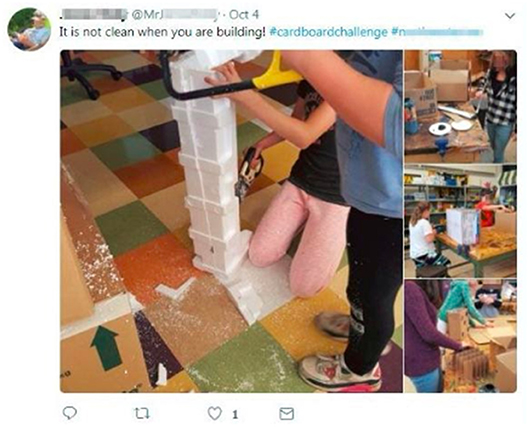
Figure 11. Twitter post from one of Norbrooke's teachers — example of students' projects filling the space.
In terms of the physical environment at Princess Elizabeth, the teacher librarian also shared that…
Having an open learning space with defined learning areas has been very important in our library…When brainstorming and planning, students can choose to work at many different areas with flexible seating. There are collaborative spaces such as our worktables and hexagon seating as well as individual loungers, so students can choose to work where they feel most comfortable. Keeping the space as uncluttered as possible has also been extremely important as this space has many different purposes.
Again, as was found at the Norbrooke site, the open and flexible qualities of the physical learning environment were extremely important in terms of student comfort, engagement, and workflow. The space could accommodate a variety of projects (independent or collaborative) and needs of the designers (i.e., students could choose where and how in the space they wished to work).
The kind of flexibility noted above was also evident at Rocky Ridge, although the space itself, as a repurposed computer lab, is smaller in size than the spaces at Norbrooke and Princess Elizabeth. The limited space required creative thinking regarding how the space was organized. A central focus in this space is on the woodworking station set up in the middle of the room. Ben was particularly passionate about giving the students opportunities to work with drills, electric screwdrivers and hammers, and nails. Rather than purchasing pre-made, commercial looms, readily available from online suppliers, the teachers felt strongly that the students should make their own looms to create “treaty bracelets” or miniature versions of wampum belts. This decision was initially made in part because of the cost involved to purchase looms, but as Ben noted, “I thought, why don't we just have them build them and the kids loved it.” This decision led the teachers to plan other woodworking projects, including the design and construction of paddles for grade 7 and 8 students, which was popular with the girls in particular. Ben reported that two girls asked him if the local high school offered “woodshop” and when he confirmed that it did, they said they would be taking the course.
It is interesting that both Rocky Ridge and Norbrooke teachers advocated for the use of power tools and woodworking, and that Princess Elizabeth chose to include construction tools like screwdrivers, hammers, hot glue guns, and pliers, at a time when many elementary schools are backing away from activities that might be considered more risky than others from a safety perspective. In an interview at Rocky Ridge, the researchers and teachers discussed the work of Tulley and Spiegler (2011), authors of Fifty Dangerous Things (You Should Let Your Children Do). Tulley and Spiegler (2011) argues that being too overprotective prevents children from having the kinds of experiences that lay the foundation for creativity. The teachers at Rocky Ridge and Norbrooke agreed that students need to be exposed to building with power tools, hammers, and nails, with appropriate supervision and care, in order to promote creativity and problem solving.
Power, Inclusion, and Space
At all three sites, we found inclusion and a shift in power, due to an inquiry-based teaching and learning approach, to be central themes. These themes looked slightly different at each site. The inclusion at Norbrooke and Princess Elizabeth was seen in the examples provided in the previous two sections as the teachers described the levels of personalized and differentiated learning the spaces afforded. Below we provide additional information on how Rocky Ridge's makerspace was also overtly designed for cultural inclusion. The second half of this section then demonstrates the shift in power between the teachers and students at each site (i.e., away from the hierarchical and toward the democratic) that was afforded by the pedagogical shift (i.e., toward inquiry)—a shift facilitated by the layout of the physical spaces.
The most prominent inclusionary feature of Rocky Ridge's makerspace was that it was designed to meet the demographic needs of the student body, which was predominantly Ojibwe. The general school space was already designed for inclusivity with various signs in both English and Ojibwe (i.e., the welcome sign at the front of the school) and other Indigenous symbols—Figure 12:
The makerspace was an extension of this inclusive tone as the space housed a variety of materials, stations and content associated with the Indigenous culture: textile and beading looms and other tools to make artifacts reflective of Indigenous regalia (Figure 13). Texts such as We Are All Treaty People were also readily available communicating the inclusivity values of the school culture.
The physical space itself, what it affords and limits, is of course one actor in the learning environment. Another important consideration is the pedagogical approach that permeates the space. In the case of Rocky Ridge, the space was specifically set up to encourage collaboration (watering holes), while at the same time, offering spaces where students could work alone (caves), and an area to work under closer supervision by teachers and facilitators (campfire). The teaching philosophy at Rocky Ridge is based on “natural curiosity” which focuses on environmental inquiry. The natural curiosity movement was established in 2011 in Canada to provide educators with a framework that combines inquiry-based learning, experiential learning, integrated learning, and stewardship. In 2018, these four components were expanded to include an Indigenous lens, to consider learning in relationship to nature through Indigenous ways of knowing. At Rocky Ridge, the makerspace offered cultural inclusivity—an empowering element facilitating engagement in the making and learning process; however, student power was still restricted, to a degree, in terms of the range of projects the space was set up to support (i.e., beading, looms) and the type of controlled inquiry generally used by the teachers. In controlled inquiry, the teacher chooses topics and identifies the resources students will use to answer questions.
At Princess Elizabeth, the space supported guided inquiry (the teacher selects the topics or challenge to explore while the students design a product or solution). There was the carpeted area where the teacher-librarian gathered the students to read a text and propose an inquiry challenge based on the text. This part of the learning would be considered the “campfire” where storytelling and knowledge is shared by an expert. Then, there were a variety of different types of “watering holes” where students could collaborate—at large, group tables, the LEGO wall, the green screen wall, the open materials area. There, students could share ideas and offer each other support in the design and making process. Finally, there were individual seats and computer stations (the caves) where students could think, synthesize and reflect on their processes. Relatively speaking, power (i.e., who was in charge of the learning process) was evenly distributed between the teacher and students.
Finally, in the case of Norbrooke, the space supported free or open inquiry, where the students were engaged in their own inquiries (Norbrooke called these “passion projects”) and the teacher was there to support the learning and making process. As with Rocky Ridge, Norbrooke's makerspace was also set up to encourage collaboration (watering holes) through the large, group tables and large floor space. The role of the campfire and expert was minimized in this space, but could still be seen in the one-on-one assistance or instruction the teacher was able to provide students when they required assistance with a tool or working through a plan or idea. Finally, the cave was also not as obvious in this learning space (i.e., no individual computers, seats, or stations a student could inhabit), however, the space was large enough that areas could be “hacked” or “repurposed” for students to engage in individual reading, reflection, and/or thinking. In this makerspace, much of the power (i.e., control of learning) was in the hands of the students.
Discussion
As Stull et al. (2018) assert, there is an important interplay between the actions and processes of the physical body and internal, cognitive functions. They refer to this as embodied learning. For example, when one engages in the physical construction of an electronic circuit, cognition, and understanding may be positively affected—mental models may be clarified, deeper understanding of a concept achieved. And, having an innovative learning space with a variety of materials and ways to both engage with and represent concepts is important, as well. As Keune and Peppler (2018) and Tan et al. (2017) point out, materials have an important influence on the making and learning process. They engage the maker in a conversation of the possible and spark ideas or set natural limitations by way of their properties. In the cases of both Norbrooke and Princess Elizabeth, the tools and materials available/visible to the students influenced what they chose to make and how, and we can only assume—what they learned from the process. Embodied making with a choice of materials facilitated engagement with theoretical concepts at Norbrooke (students could represent their understanding through a physical engagement with and representation of a concept as opposed to a simple description of it on paper). At Princess Elizabeth, the materials facilitated or constrained student designs of a leprechaun trap. Students iteratively consulted with the materials to uncover what might be possible in terms of design and construction. At Rocky Ridge, the activities the researchers observed were designed as a controlled inquiry by the teachers and Indigenous facilitator. The projects and materials were selected by them; however, students had some choice in the design of their beaded bracelets and had some freedom to move between and among the various stations.
In terms of neuroarchitecture, in the case of Norbrooke, the space encouraged the students to think and build big. The cavernous room with its high ceilings and huge swathes of empty floor space between workstations invited the students to take up space and to think on a scale larger than what is afforded in a standard classroom. The resultant ideas and projects were large, unique and unprecedented. The spacious walkways between work stations also encouraged the students to circulate to see what others were making. This, in turn, had an effect on the students' own making and learning processes as they collected ideas and inspiration from their classmates. The space became a sort of creative incubator. At Princess Elizabeth, the well-defined spaces (i.e., green screen/video production, construction, LEGO wall, and robotics) influenced how students moved within the space, what activities they engaged in and how. For example, in the construction area with the materials bins and construction tools the students knew that they were allowed to choose their materials and tools after consultation with the teacher. This consultation was included to reduce the possibility of waste. They also knew that there was an expectation of collaboration and idea-sharing as the work tables were communal. This speaks to the idea that the physical structure of a space is never neutral and empirical research from Crawford Barniskis (2016) who explains that “[l]ibrary creative places shape the possible actions and experiences of those using them through policy and practice, including the planning and implementation of spatial arrangements” (p. 1). In this case, students' possible actions were determined by the spatial arrangement of the makerspace/library and the space “…arrangements of tools and materials within the space demonstrate[d] how the library interprets its use, and how it legitimize[d] particular activities or groups within the space” (p. 2). At Princess Elizabeth, it was apparent that the librarian and staff were working toward “…recalibrat[ing] their message from ‘keep out' to ‘come in”' (Crawford Barniskis, 2016, p. 9).
With regards to the power dynamic present at each of the sites, at Princess Elizabeth and Rocky Ridge, some choice was embedded in the student projects (i.e., through materials selection and the final design), however, the making was still structured. At Princess Elizabeth, all the students still focused on the same objective: building a trap to catch a leprechaun—reflective of guided inquiry. At Rocky Ridge, even greater control was seen in the making process as both the project and the materials were pre-selected. The stations were all designed activities and reflective of controlled inquiry. In this type of inquiry the teacher chooses topics and identifies the resources students will use to answer questions. At Norbrooke, the students appeared to have more choice in what, how and with what they made while in the makerspace. As a result, their process was more reflective of free inquiry, where the students determine what topics they would like to explore and how they would like to approach the learning. In all three spaces, opportunities for campfires, watering holes and caves were observable, reflecting the different types of inquiry happening in each space. At Norbrooke, the minimized campfire (teacher as just-in-time facilitator) reflected the kind of free inquiry pedagogy happening in that space. At Princess Elizabeth, the clearly defined and balanced time allocated in the session to the campfire (storytelling), watering hole (collaboration), and cave (desk/computer area) reflected guided inquiry in that space. Finally, the pre-defined stations/activities, which were at times, led by teacher experts, reflected the kind of controlled inquiry approach happening in that space. In all three cases, what students made and learned was influenced by their making objectives. These objectives were defined by the style of inquiry, how the students moved through the physical makerspaces and interacted with one another and what tools and materials they had access to.
Implications and Conclusions
The educational importance of this study includes an articulated need for further, more involved research into the impact of the physical maker learning environment on student engagement and achievement. Furthermore, with the beginning of “innovative learning spaces” being installed in school districts across Ontario and beyond, having more informed research on considerations for best practices associated with teaching and learning in these spaces is necessary (considerations including optimal space, dimensions of a room, materials, lighting, temperature, and noise levels).
From the three sites it became clear that the materials in each makerspace engaged students in conversations of the possible. The materials and the ways in which they were displayed (i.e., visible) supported “…the incubation of new ideas” (Tan et al., 2017, p. 193). The spaces were also constructed in a way that non-verbally communicated to students: “spread out”; “take up space”; “adapt the space and adapt to the space to create a more personalized experience.” There was both literal and metaphorical room in these makerspaces to accommodate student needs, interests and aspirations. The spaces also fostered collaboration as the students could easily share and display their works in progress and their final products.
It is important to note that regardless of the construction activities that were happening in the spaces (woodworking, circuit-building, beading, etc.) the students were all recruiting and developing the transversal skills and global competencies (i.e., problem-solving; critical thinking; meta-cognition; collaboration) that are now the focus of many educational systems, including many parts of Canada and the world. This unique approach to education, however, also allows for the kind of student-centered and personalized learning experience that educators have tried so desperately (and often unsuccessfully) to move toward for decades.
Future research might look more closely at the relationship between the makerspace environment and student achievement or mastery. For example, one might examine student achievement based on the students': (1) level of engagement in learning within the makerspace; (2) quality of products designed in the space (quality products could be defined by the level of creativity and critical thinking apparent in the products), and (3) overall degree of mastery. One might conduct a pre-assessment of student engagement and achievement prior to a redesign of a learning space using the three points above (level of engagement, quality products, and degree of mastery) as they relate to the traditional classroom. Then, once the space has been redesigned in accordance with the findings from the theoretical framework (accounting for things like natural and good lighting, biophilic design, high ceilings, expansive floor space, the display of tools, and materials and inclusive design that reflects the community of learners and invites a democratic engagement with the space) one might then observe and collect data on the students and their making based on the three points previously outlined. A comparison of these three points could then be made to see what, if anything, may have changed in terms of student engagement and/or achievement. There could also be an opportunity to conduct a second qualitative study following up on student experiences (through interviews or focus groups) and what may or may not have influenced the students' engagement, making, and achievement.
For those looking to create a makerspace in their school or learning context, recommendations include the following: (1) think big, start small, but start; (2) take risks to shift pedagogies, and (3) create a makerspace that reflects its community of users. Building a makerspace can feel overwhelming and can be costly. However, it does not have to be. It is possible to start simply with low-cost construction materials. If one decides the environment has to first be perfect, the likelihood of starting a makerspace and experiencing the positive effects on learning will remain low. So start small, but start. The most important feature of a makerspace is the shift in mindset by the users. This shift in mindset requires that both the teachers and learners understand a few key elements of the making process: it is inquiry-based, failure is part of the process, learning happens through making, and there are many experts in the room (not just the teacher). Making can happen anywhere, at any time and with any tools—plugged or unplugged, expensive or not. What is most important is the pedagogical approach. Finally, the tools and materials included in a makerspace need to reflect its community of users. As making is student-centered and passion-driven, the tools and materials in a space need to reflect the interests and identities of the students and the needs of the surrounding community. As a result, no two makerspaces will look exactly the same.
Data Availability Statement
The datasets generated for this study are available on request to the corresponding author.
Ethics Statement
The studies involving human participants were reviewed and approved by Ontario Tech University Research Ethics Board. The patients/participants provided their written informed consent to participate in this study. Written informed consent was obtained from the individual(s) for the publication of any potentially identifiable images or data included in this article.
Author Contributions
All authors listed have made a substantial, direct and intellectual contribution to the work, and approved it for publication.
Funding
This research was funded by the Ontario Ministry of Education, CODE (the Council of Ontario Directors of Education), and the Canada Research Chair Program.
Conflict of Interest
The authors declare that the research was conducted in the absence of any commercial or financial relationships that could be construed as a potential conflict of interest.
References
Albright, T. D. (2015). “Neuroscience for architecture,” in Mind in Architecture: Neuroscience, Embodiment and the Future of Design, eds S. Robinson and J. Pallasmaa (Cambridge, MA: MIT Press), 197–217.
Barsalou, L. W. (2010). Grounded cognition: past, present, and future. Topics Cogn. Sci. 2, 716–724. doi: 10.1111/j.1756-8765.2010.01115.x
Black, A., and Pepper, S. (2012). From civic place to digital space: the design of public libraries in britain from past to present. Library Trends 61, 440–470. doi: 10.1353/lib.2012.0042
Crawford Barniskis, S. (2016). “Creating space: the impacts of spatial arrangements in Public Library Makerspaces,” in Paper presented at: IFLA WLIC 2016. Community in Session 79 (Columbus, OH, Connections; Collaboration; Library Theory and Research).
Determan, J., Akers, M. A., Albright, T., Browning, B., Martin-Dunlop, C., Archibald, P., et al. (2019). The Impact of Biophilic Learning Spaces on Student Success. Retrieved from: https://cgdarch.com/wp-content/uploads/2019/12/The-Impact-of-Biophilic-Learning-Spaces-on-Student-Success.pdf (accessed February 28, 2020).
Ellard, C. (2015). Places of the Heart: The Psychogeography of Everyday Life. New York: Bellevue Literary Press.
Foucault, M. (1978). Discipline & Punish. The Birth of the Prison. Available online at: https://monoskop.org/images/4/43/Foucault_Michel_Discipline_and_Punish_The_Birth_of_the_Prison_1977_1995.pdf
Freeman, A., Adams Becker, S., Cummins, M., Davis, A., and Hall Giesinger, C. (2017). NMC/CoSN Horizon Report: 2017 K-12 Edition. Austin, TX: The New Media Consortium.
Glenberg, A. (2010). Embodiment as a unifying perspective for psychology. WIRE Cogn. Sci. 1, 586–596. doi: 10.1002/wcs.55
Gramsci, A. (1988). “Working-class education and culture,” in The Gramsci Reader: Selected Writings 1916-1935, ed D. Forgacs (New York, NY: New York University Press), 53–75.
Griffis, M. R. (2013). Space, power and the public library: A multicase examination of the public library as organization space. (Ph.D. dissertation). The University of Western Ontario. Retrieved from: http://ir.lib.uwo.ca/etd/1103 (accessed February 28, 2020).
Hughes, J. (2017). “Meaningful making: establishing a makerspace in your school or classroom,” in What Works? Research into Practice (Toronto, ON: Queen's Printer; Literacy Numeracy Secretariat; Ontario Ministry of Education).
Jaatinen, J., and Lindfors, E. (2019). Makerspaces for pedagogical innovation processes: how finnish comprehensive schools create space for makers. Design and Technology Education: An International Journal. Available online at: https://ojs.lboro.ac.uk/DATE/article/view/2623/2810 (accessed February 28, 2020).
Keune, A., and Peppler, K. (2018). Materials-to-develop-with: the making of a makerspace. Br. J. Educ. Technol. 50, 280–293. doi: 10.1111/bjet.12702
Lehman, C., and Chase, Z. (2015). Building School 2.0: How to Create the Schools We Need. San Francisco, CA: Wiley.
Li, D., and Sullivan, W. C. (2016). Impact of views to school landscapes on recovery from stress and mental fatigue. Landsc. Urban Plan. 148, 149–158. doi: 10.1016/j.landurbplan.2015.12.015
MacKenzie, T. (n.d.). Types of Student Inquiry. tmac. Available online at: https://www.trevormackenzie.com/exclusive-sketchnotes (accessed February 28, 2020).
Mehta, R., and Zhu, R. (2009). Blue or red? Exploring the effect of color on cognitive task performances. Science 323, 1226–1229. doi: 10.1126/science.1169144
Meyers-Levy, J., and Zhu, R. (2007). The influence of ceiling height: the effect of priming on the type of processing that people use. J. Consumer Res. 34, 174–186. doi: 10.1086/519146
Mott, M. S., Robinson, D. H., Williams-Black, T. H., and McClelland, S. S. (2014). The supporting effects of high luminous conditions on grade 3 oral reading fluency scores. SpringerPlus 3:53. doi: 10.1186/2193-1801-3-53
Nordquist, J., and Watter, M. (2017). Participatory design beyond borders. Eur. J. Educ. 52, 327–335. doi: 10.1111/ejed.12227
Stake, R. E. (2005). “Qualitative case studies,” in The Sage Handbook of Qualitative Research, 3rd Edn., eds N. K. Denzin and Y. S. Lincoln (Thousand Oaks, CA: Sage), 443–466.
Stull, A. T., Gainer, M. J., and Hagerty, M. (2018). Learning by enacting: the role of embodiment in chemistry education. Learn. Instr. 55, 80–92. doi: 10.1016/j.learninstruc.2017.09.008
Sullivan, C. C. (2012). “Pick school classroom furniture that promotes healthy and attentive students,” in School Classroom Furniture. Available online at: https://www.buildings.com/article-details/articleid/13456/title/school-classroom-furniture#
Suter, W. N. (2012). Introduction to Educational Research: A critical Thinking Approach 2nd Edn. Thousand Oaks, CA: Sage. doi: 10.4135/9781483384443
Tan, V., Keune, A., and Peppler, K. (2017). “The materiality of design in e-textiles,” in Taking design thinking to school: How the Technology of Design Can Transform Teachers, Learners, and Classrooms, eds S. Goldman and Z. Kabayadondo (New York, NY: Routledge), 180–194.
Thayer, J. F., Verkuil, B., Brosschot, J. F., Kampschroer, K., West, A., Sterling, C., et al. (2010). Effects of the physical work environment on physiological measures of stress. Eur. J. Cardiovasc. Prev. Rehab. 17, 431–439. doi: 10.1097/HJR.0b013e328336923a
Thornburg, D (2004). Campfires in Cyberspace: Primordial Metaphors for Learning in the 21st Century. Available online at: http://www.itdl.org/Journal/Oct_04/invited01.htm (accessed February 28, 2020).
Tondeur, J., Herman, F., De Buck, M., and Triquet, K. (2017). Classroom biographies: teaching and learning in evolving material landscapes (c. 1960-2015). Eur. J. Educ. 52, 280–294. doi: 10.1111/ejed.12228
Tulley, G., and Spiegler, J. (2011). 50 Dangerous Things (You Should Let Your Children Do. New York, NY: Tinkering Unlimited.
Wu, C.-D., McNeely, E., Cedeno-Laurent, J., Plan, W.-C., Adamkiewicz, G., Dominici, F., et al. (2014). Linking student performance in Massachusetts elementary schools with the “greenness” of school surroundings using remote sensing. PLoS ONE 9:e108548. doi: 10.1371/journal.pone.0108548
Keywords: makerspace, inquiry, embodied learning, materiality, innovative spaces, inclusive practices
Citation: Hughes JM and Morrison LJ (2020) Innovative Learning Spaces in the Making. Front. Educ. 5:89. doi: 10.3389/feduc.2020.00089
Received: 18 March 2020; Accepted: 22 May 2020;
Published: 03 July 2020.
Edited by:
Chunxia Qi, Beijing Normal University, ChinaReviewed by:
Allen Leung, Hong Kong Baptist University, Hong KongKathryn Holmes, Western Sydney University, Australia
Copyright © 2020 Hughes and Morrison. This is an open-access article distributed under the terms of the Creative Commons Attribution License (CC BY). The use, distribution or reproduction in other forums is permitted, provided the original author(s) and the copyright owner(s) are credited and that the original publication in this journal is cited, in accordance with accepted academic practice. No use, distribution or reproduction is permitted which does not comply with these terms.
*Correspondence: Laura Jane Morrison, bGF1cmEubW9ycmlzb24xQG9udGFyaW90ZWNodS5uZXQ=
†These authors have contributed equally to this work
 Janette Michelle Hughes
Janette Michelle Hughes Laura Jane Morrison
Laura Jane Morrison